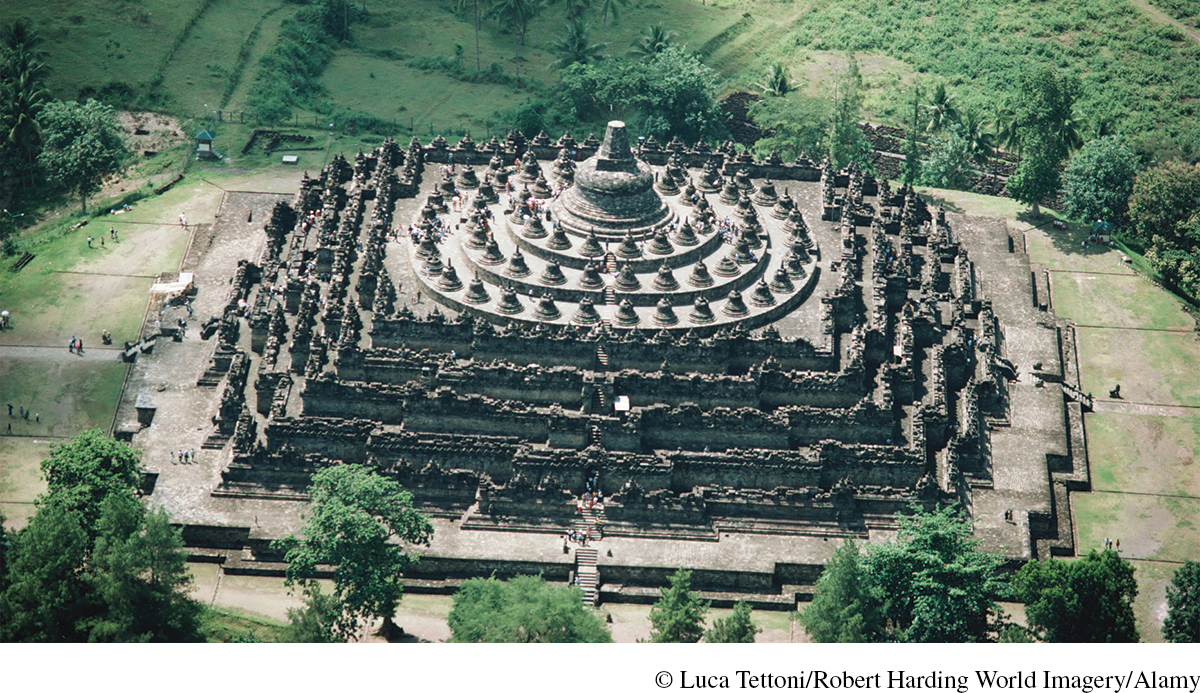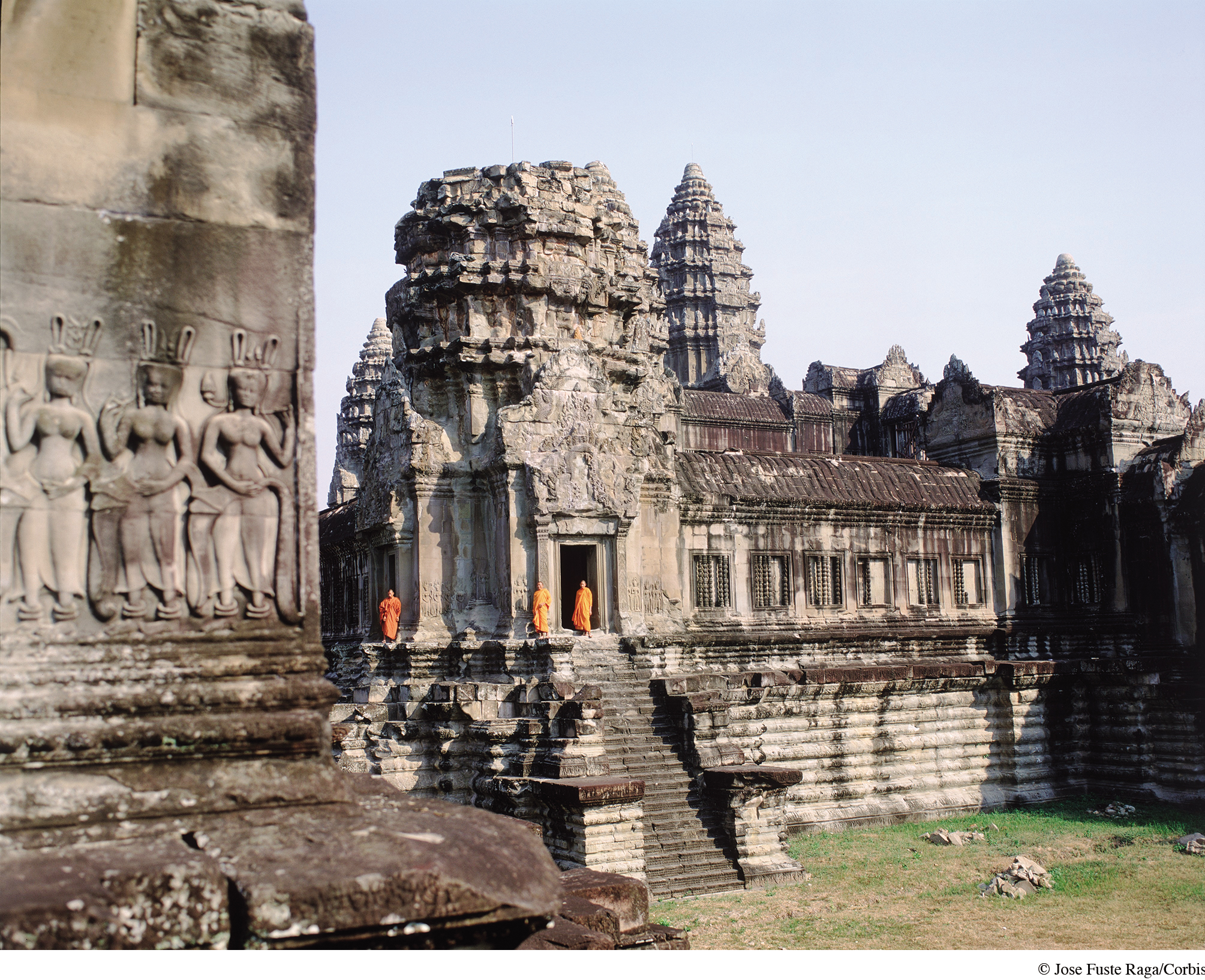Sea Roads as a Catalyst for Change: Southeast Asia
In what ways did Indian influence register in Southeast Asia?
Oceanic commerce transformed all of its participants in one way or another, but nowhere more so than in Southeast Asia and East Africa, at opposite ends of the Indian Ocean network. In both regions, trade stimulated political change as ambitious or aspiring rulers used the wealth derived from commerce to construct larger and more centrally governed states or cities. Both areas likewise experienced cultural change as local people were attracted to foreign religious ideas from Confucian, Hindu, Buddhist, or Islamic sources. As on the Silk Roads, trade was a conduit for culture.

Map 7.3 Southeast Asia, ca. 1200 C.E. Both mainland and island Southeast Asia were centrally involved in the commerce of the Indian Ocean basin, and both were transformed by that experience.
Located between the major civilizations of China and India, Southeast Asia was situated by geography to play an important role in the evolving world of Indian Ocean commerce. During the third-wave era, a series of cities and states or kingdoms emerged on both the islands and mainland of Southeast Asia, representing new civilizations in this vast region (see Map 7.3). That process paralleled a similar development of new civilizations in East and West Africa, Japan, Russia, and Western Europe in what was an Afro-Eurasian phenomenon. In Southeast Asia, many of those new societies were stimulated and decisively shaped by their interaction with the sea-based trade of the Indian Ocean.11
The case of Srivijaya (SREE-vih-juh-yuh) illustrates the connection between commerce and state building. When Malay sailors, long active in the waters around Southeast Asia, opened an all-sea route between India and China through the Straits of Malacca around 350 C.E., the many small ports along the Malay Peninsula and the coast of Sumatra began to compete intensely to attract the growing number of traders and travelers making their way through the straits. From this competition emerged the Malay kingdom of Srivijaya, which dominated this critical choke point of Indian Ocean trade from 670 to 1025. A number of factors—Srivijaya’s plentiful supply of gold; its access to the source of highly sought-after spices, such as cloves, nutmeg, and mace; and the taxes levied on passing ships—provided resources to attract supporters, to fund an embryonic bureaucracy, and to create the military and naval forces that brought some security to the area.
The inland states on the mainland of Southeast Asia, whose economies were based more on domestically produced rice than on international trade, nonetheless participated in the commerce of the region. The state of Funan, which flourished during the first six centuries of the Common Era in what is now southern Vietnam and eastern Cambodia, hosted merchants from both India and China. Archeologists have found Roman coins as well as trade goods from Persia, Central Asia, and Arabia in the ruins of its ancient cities. The Khmer kingdom of Angkor (flourished 800–1300) exported exotic forest products, receiving in return Chinese and Indian handicrafts, while welcoming a considerable community of Chinese merchants. Traders from Champa in what is now central and southern Vietnam operated in China, Java, and elsewhere, practicing piracy when trade dried up. Champa’s effort to control the trade between China and Southeast Asia provoked warfare with its commercial rivals.
Beyond the exchange of goods, commercial connections served to spread elements of Indian culture across much of Southeast Asia, even as Vietnam was incorporated into the Chinese sphere of influence. (See Chapter 8 for more on Chinese influence in Vietnam.) Indian alphabets such as Sanskrit and Pallava were used to write a number of Southeast Asian languages. Indian artistic forms provided models for Southeast Asian sculpture and architecture, while the Indian epic Ramayana became widely popular across the region.
Politically, Southeast Asian rulers and elites found attractive the Indian belief that leaders were god-kings, perhaps reincarnations of a Buddha or the Hindu deity Shiva, while the idea of karma conveyed legitimacy to the rich and powerful based on their moral behavior in earlier lives. Srivijayan monarchs, for example, employed Indians as advisers, clerks, or officials and assigned Sanskrit titles to their subordinates. The capital city of Palembang was a cosmopolitan place, where even the parrots were said to speak four languages. While these rulers drew on indigenous beliefs that chiefs possessed magical powers and were responsible for the prosperity of their people, they also made use of imported Indian political ideas and Buddhist religious concepts, which provided a “higher level of magic” for rulers as well as the prestige of association with Indian civilization.12 They also sponsored the creation of images of the Buddha and various bodhisattvas whose faces resembled those of deceased kings and were inscribed with traditional curses against anyone who would destroy them. Srivijaya grew into a major center of Buddhist observance and teaching, attracting thousands of monks and students from throughout the Buddhist world. The seventh-century Chinese monk Yi Jing was so impressed that he advised Buddhist monks headed for India to study first in Srivijaya for several years.

Borobudur This huge Buddhist monument, constructed probably in the ninth century C.E., was subsequently abandoned and covered with layers of volcanic ash and vegetation as Java came under Islamic influence. It was rediscovered by British colonial authorities in the early nineteenth century and has undergone several restorations over the past two centuries. Although Indonesia is a largely Muslim country, its small Buddhist minority still celebrates the Buddha’s birthday at Borobudur. (© Luca Tettoni/Robert Harding World Imagery/Alamy)
Elsewhere as well, elements of Indian culture took hold in Southeast Asia. The Sailendra kingdom in central Java, an agriculturally rich region closely allied with Srivijaya, mounted a massive building program between the eighth and tenth centuries featuring Hindu temples and Buddhist monuments. The most famous, known as Borobudur, is an enormous mountain-shaped structure of ten levels, with a three-mile walkway and elaborate carvings illustrating the spiritual journey from ignorance and illusion to full enlightenment. The largest Buddhist monument anywhere in the world, it is nonetheless a distinctly Javanese creation, whose carved figures have Javanese features and whose scenes are clearly set in Java, not India. Its shape resonated with an ancient Southeast Asian veneration of mountains as sacred places and the abode of ancestral spirits. Borobudur represents the process of Buddhism becoming culturally grounded in a new place.

Angkor Wat Constructed in the early twelfth century, the Angkor Wat complex was designed as a state temple, dedicated to the Hindu god Vishnu and lavishly decorated with carved bas-reliefs depicting scenes from Hindu mythology. By the late thirteenth century, it was in use by Buddhists, as it is to this day. This photo shows a small section of the temple and three Buddhist monks in their saffron robes. (© Jose Fuste Raga/Corbis)
Hinduism too, though not an explicitly missionary religion, found a place in Southeast Asia. It was well rooted in the Champa kingdom, for example, where Shiva was worshipped, cows were honored, and phallic imagery was prominent. But it was in the prosperous and powerful Angkor kingdom of the twelfth century C.E. that Hinduism found its most stunning architectural expression in the temple complex known as Angkor Wat. The largest religious structure in the premodern world, it sought to express a Hindu understanding of the cosmos, centered on a mythical Mount Meru, the home of the gods in Hindu tradition. Later, it was used by Buddhists as well, with little sense of contradiction. To the west of Angkor, the state of Pagan likewise devoted enormous resources to shrines, temples, and libraries inspired by both Hindu and Buddhist faiths.
This extensive Indian influence in Southeast Asia has led some scholars to speak of the “Indianization” of the region, similar perhaps to the earlier spread of Greek culture within the empires of Alexander the Great and Rome. In the case of Southeast Asia, however, no imperial control accompanied Indian cultural influence. It was a matter of voluntary borrowing by independent societies that found Indian traditions and practices useful and were free to adapt those ideas to their own needs and cultures. Traditional religious practices mixed with the imported faiths or existed alongside them with little conflict. And much that was distinctively Southeast Asian persisted despite influences from afar. In family life, for example, most Southeast Asian societies traced an individual’s ancestry from both the mother’s and father’s line in contrast to India and China, where patrilineal descent was practiced. Furthermore, women had fewer restrictions and a greater role in public life than in the more patriarchal civilizations of both East and South Asia. They were generally able to own property together with their husbands and to initiate divorce. A Chinese visitor to Angkor observed, “It is the women who are concerned with commerce.” Women in Angkor also served as gladiators, warriors, and members of the palace staff, and as poets, artists, and religious teachers. Almost 1,800 realistically carved images of women decorate the temple complex of Angkor Wat. In neighboring Pagan, a thirteenth-century queen, Pwa Saw, exercised extensive political and religious influence for some forty years amid internal intrigue and external threats, while donating some of her lands and property to a Buddhist temple. Somewhat later, but also via Indian Ocean commerce, Islam too began to penetrate Southeast Asia as the world of seaborne trade brought yet another cultural tradition to the region.


